Super telephoto prime lenses must have the largest learning curve of any prime lens. The long focal length means your subjects need to be far away from you to capture any real amount of them. Longer focal lengths are also increasingly subject to the Reciprocal Rule of shutter speed, to avoid blurry images.
However, so long as you know what you’re getting into, the Canon 200mm f/2.8 II L is one of the finest telephoto fast primes on the market! Let’s look at what it has to offer!
Canon EF 200mm f/2.8L II USM
Base Specifications:
- Minimum Focusing Distance: 1.5m (4.92ft)
- Maximum Aperture: f/2.8
- Focusing Motor: Ring Ultrasonic Stepping Motors
- Reproduction Ratio: 0.26x
- Weather-Sealed: No
- Image Stabilization: No
- Weight: 795 g.
- Price: check Amazon
Note that the Canon EF mount is fully compatible both with Canon’s APS-C and Full-frame body lineup. When mounted onto a Canon APS-C body like the T7i, you instead have a focal length of 320mm. This gives you quite a bit of pseudo-reach. And while your aperture’s total light exposure is f/2.8, you’ll have an appearance closer to f/4 when paired with an APS-C camera.
Build Quality:
Like all Canon L lenses, the 200mm f/2.8 is entirely weather-sealed. When paired with a weatherized Canon body like the EOS 7D Mark II the camera is resistant to dust and moisture exposure.
In terms of the total amount of glass, we have 9 elements in 7 groups, with 2 elements constructed of low dispersion UD glass. Eight diaphragm blades create excellent bokeh shapes and the lens can be stopped down as far as f/32.
On the rear of the lens near is a distance scale displayed in meters and feet, with a glass window covering it for protection. Two switches are nearby as well – the first switch allows you to toggle between autofocus and manual focus.
The second switch allows you to set the minimum range of focusing (from 1.5m to infinity vs 3.5m to infinity). Focus limiters like these are incredibly handy for speeding up focus acquisition if you know your subject won’t be within the minimum focusing distance (i.e. sports, portraiture).
Sharpness:
As a quality telephoto prime lens, we want optimal sharpness and the Canon 200mm f/2.8 II does not disappoint. Even wide open at f/2.8 sharpness is stellar across the image frame. Lesser prime lenses see a drop when you get to the extreme corners however there is no noticeable loss in image quality.
Pairing the 200mm f/2.8 with an APS-C body will give you slightly sharper results because the smaller sensor is only making use of the inner, sharper portions of the lens glass. Like nearly all lenses stopping down does improve sharpness however we see minimal improvements. Sharpness peaks around f/4 to f/5.8 but again, this lens is a razor wide open!
If you see significant sharpness loss, you should consider two particular quirks of telephoto lenses. Firstly, the Reciprocal Rule of Shutter Speed states that you should always be using at least the inverse of your focal length to keep images free from motion blur due to your hands not being perfectly stable.
For a 200mm lens, this means you’ll want a shutter speed of 1/200ths of a second, maximum. Any slower and you’ll start to lose sharpness. Adjusted when used with an APS-C body means a maximum of 1/320ths of a second.
Second, compression can enhance the effects of atmospheric haze, fog, dust, and other particulates in between you and an especially far subject. This is especially common in landscape photography. The haze will greatly reduce contrast, clarity, and sharpness, depending on the environment, making it appear as if your lens lacks resolution somehow. A Circular Polarizing filter can help immensely when shooting through a thick layer of air.
Below are the MTF charts in the form of two types (Bar & Lines) for illustration. Read more about MTF charts from here.
Note: 30 LPMM always considered the average result of a decent resolution. Higher than 30 you get a more sharp image, lower than 30 sharpness decreases.
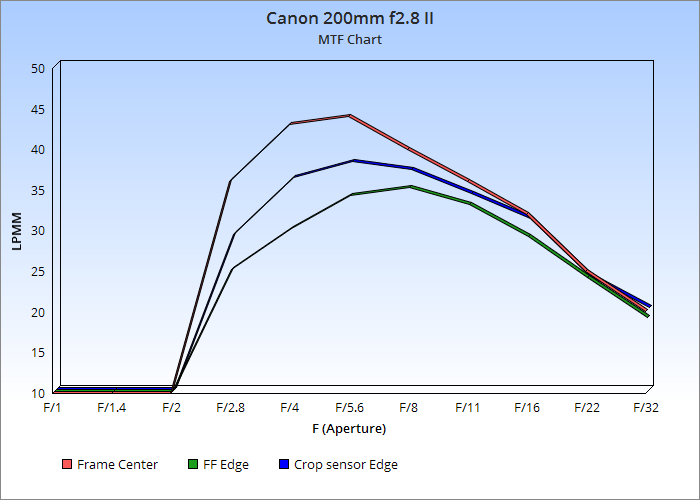
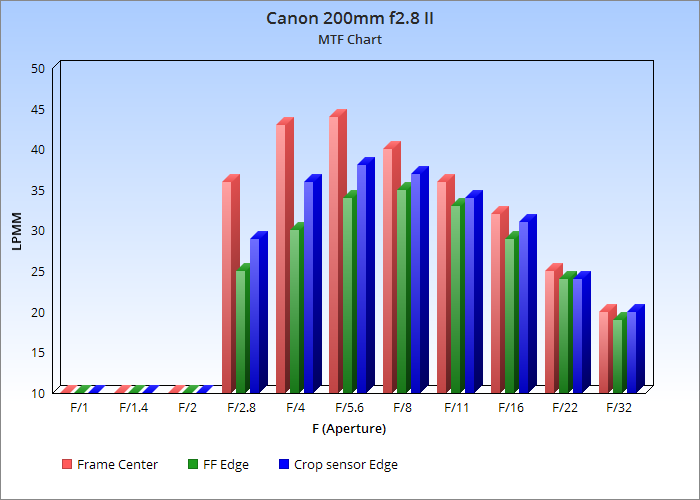
Chromatic Aberrations and Distortion:
So minimal as to be non-existent. Even when shooting in challenging lighting environments like tree branches lit with overhead sun chromatic aberrations are nearly non-existent wide open and disappear entirely when stopped down.
Like most telephoto primes the Canon 200mm f/2.8 II is also nearly perfectly optically corrected for distortion. When paired with a Canon APS-C body you’re looking at around 0.5% pincushion distortion, increasing to roughly 1% when paired with a full-frame camera.
Other Issues:
The lack of image stabilization really hurts this lens. With such a long focal length, we don’t want to dip below 1/200th-1/320th of a second in order to avoid sharpness losses due to handshake.
Being a relatively fast telephoto lens, f/2.8 is enough to compensate in most lighting conditions. Still, you’ll want to carry a tripod in challenging lighting conditions to give you more flexibility in how you expose the image.
If you need even more reach for sports and wildlife shots, the Canon Extender 1.4x and the Canon Extender 2x are fully compatible with this lens, including full autofocus performance. However, that does come at the cost of some image quality. Particularly, chromatic aberrations (purple fringing) and some loss in sharpness.
Sample Photos:
Lastly, the Canon EF 70-200mm f/2.8L IS II and III are undoubtedly more versatile by virtue of being zoom lenses. On the other hand, they both weigh and cost 2-3x more.
Overall, it’s really hard to find fault with this lens. I could say it’s an odd focal length and not nearly as versatile as the 70-200mm f/2.8 or even the 100mm f/2.8 for general use and portraiture. But for sports, wildlife, and other uses where you know your subjects will remain distant it is one of the best primes on the market. Paired that fast f/2.8 aperture with a tripod or monopod and you’ll have stellar images regardless of the environment.
This lens only loses points for a price to quality because the older Canon 200mm f/2.8 (version I) is also extremely good and roughly half the price. The version II model is better corrected for chromatic aberrations and is slightly sharper. So if every pixel of resolution is what you’re after, the version II model becomes a 10/10 for you!
Walk through the below video for more sample photos
My Overall Rating (Out of 10)
- Build Quality: 10
- Auto Focus: 9
- Distortion Handling: 10
- Sharpness: 10
- Price/Quality ratio: 8
Thanks for reading, I hope you enjoyed the article if you have any questions just post below & I will be happy to answer you.
If you enjoy the site, don’t forget to subscribe, we will only inform you when a new article is posted.

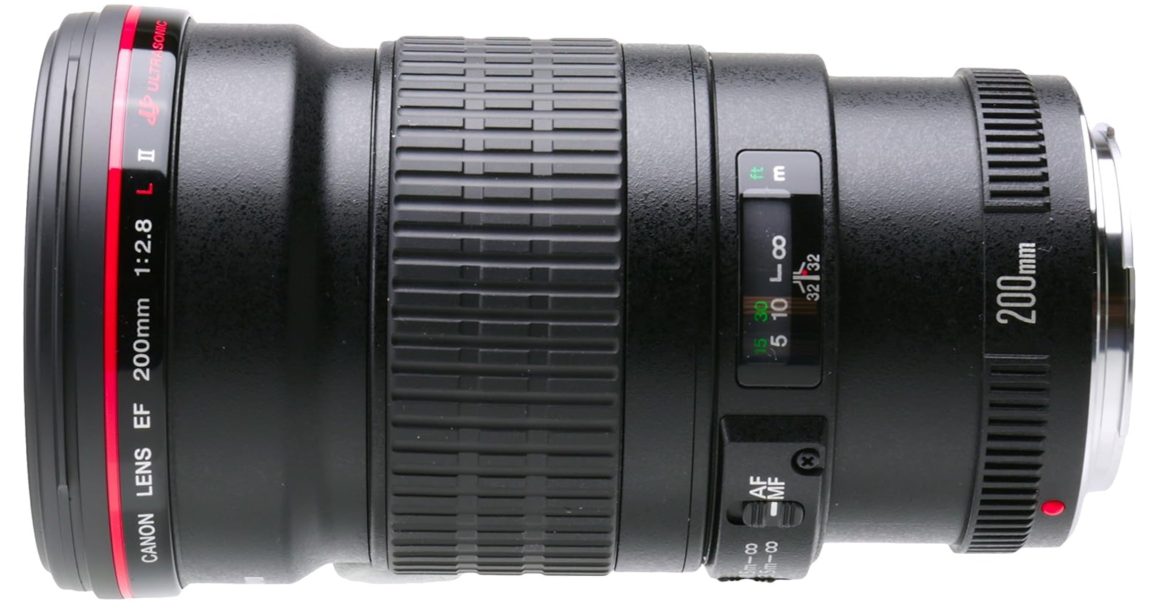





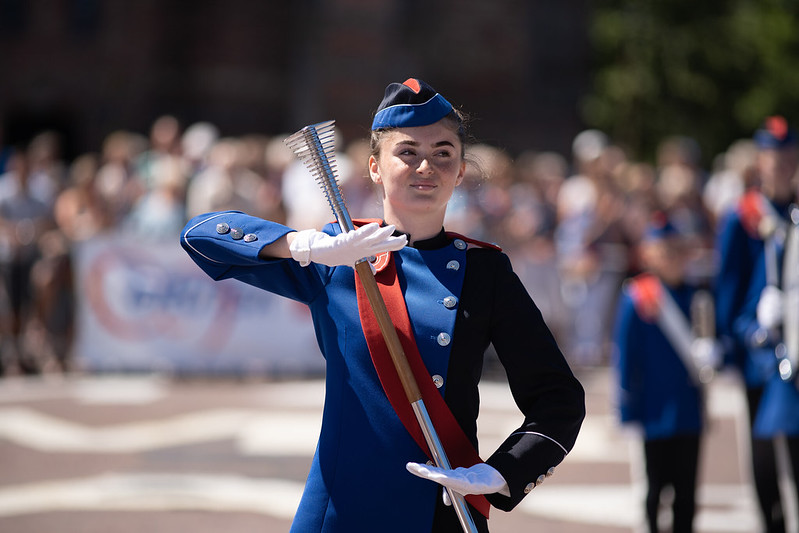


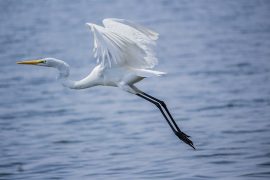



I have searched extensively but not found any proof that the second version would be any different than the first version except for the hood. I have read lots of statements like yours but I have never seen the source. Ehat makes you think that the second version is better?
Hi, as I mentioned at the end that it’s very close in performance with the old version only slightly sharper and better handling of chromatic aberrations. Remember that the old 200mm was marketed on 1991 this is the reason why it’s hard to find MTF charts for it. However, using both & testing them by shooting wide open you will find this slight difference in sharpness. Even the weight is almost the same & the build quality, also sadly they didn’t add IS in the newer version which makes the 70-200 F/2.8 II IS always a better option if you are okay with carrying heavy lenses.
I found your article to be very interesting. It made me want to sign up for some courses to learn photography. That will have to be at a later date. You gave very good information on the lens and why you would want to go with it. You made some interesting points about shutter speed and apertures that an experienced photographer would need to know.
I watched your video of sample pictures and they were very good. The lion got my wife’s attention about how sharp the image was and she said “pretty kitty, BIG kitty and that you must be very brave to take such a photo.
Overall, I found your site to be very informative and useful. I can see how someone would want to go to you to learn how to not only become a photographer but that you would be willing to help them find the right equipment for them to be successful.
Jerry
Thanks Jerry.
I’ve been taking a photography course, and I’ve been learning a lot. I never imagined there so many different lenses for everything!
Regarding the Canon 200mm, do you know if it’s compatible with Canon IOS Rebel t6? That’s the camera I bought.
I’d like to take photos of the moon one day, but in the meantime, I’m focusing on portraits and landscapes. There’s so much to learn!
Thanks for sharing.
Yeah, it’s EF mount it can fit on your t6. read more about camera lens mounts from here. The lens is amazing for portraits. No IS can make moon shots pretty hard to achieve as well as 200mm isn’t enough for close up moon shots.
I do love to take photos, especially off wildlife and portraits. I’d like to ask to do you think this lens would be good for a near beginner to purchase or should I try something different? I do like that the distance scale is embedded in making it helpful. Thanks for this honest review.
This depends on which camera you have & your photography type. This lens is a great portrait lens for full-frame cameras.